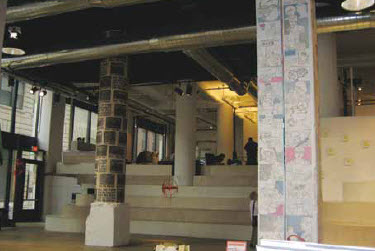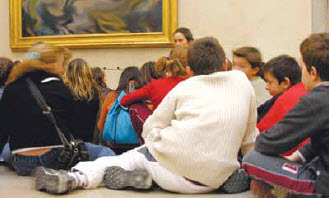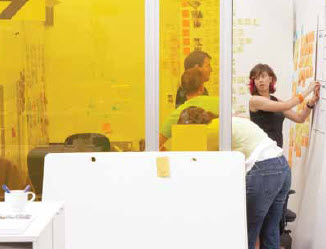Hospitable Workplace
Mixed-use can mean much more than just the physical grouping of different types of real estate. Fred Dust and Patrice Martin chronicle the cross-pollination of hotel and workplace design.
Workspace design has always looked to the outside world, the “real” world for ideas and metaphors for creating innovative environments. Largely, workspace has referenced the places that excel in efficiency and productivity, but as the work we do requires new skills, greater collaboration, and knowledge sharing the question surfaces: “Where should we look to deliver experiences that promote new ideas, sharing and innovation?” Absent from the canon of real world spaces that inspire innovation is hospitality (specifically hotels) and yet it may be one of the richest areas for exploration. When we have looked at hospitality for inspiration it has frequently been to borrow efficiency models. Workplace “hoteling” is often associated with stripping away the personal and creating simple and generic space typologies. Surely there is more to learn from hospitality?
|
|
| Principle 1: Bring the outside world in. |
As a multi-disciplinary design consultancy, IDEO’s work in the realm of space design has taken us from healthcare to hospitality, workplace to retail, to learning spaces and beyond. We have sent anthropologists, sociologists, and designers into the world of hospitality to source insight in regards to relaxation and luxury. Surprisingly they have often emerged with deeper observations on the ways people work and think in these settings. They’ve observed how co-workers congregate in busy hotel lobbies to talk shop over drinks, noting that cafes function as better environments for coming up with ideas than the office itself. These spaces aren’t quiet, they aren’t production focused, and they seem impossibly inefficient, yet great thinking is happening here. So much so that corporate culture now purposely uses off-site experience to promote fresh thinking amongst their employees. What can we extrapolate from these successful out-of-office experiences to better enrich the convential physical office?
“We come back from a long day and all end up hanging out in the hotel bar. We’re not technically working, but this is where we always come up with our best stuff.”
While old models of workplace interaction are based on formal interchange, new modes of work place collaboration rely on our ability for casual exchange. Being able to flow in and out of conversation and simply enjoy one another’s company allows us to work effortlessly together.
Teams are more successful when put into environments that foster inherent social dynamics. We already know how to relate to each other, we’re just better at it in social contexts. People need to feel at liberty to generate, share and explore ideas beyond the confines of their defined role. You can’t think of something outside of the box when you feel constrained by boundaries. Different environs allow people to enter different states of mind.
Principle 1: Bring the outside world in
Hospitality has the advantage of a connection to the outside world. It will always be stimulating and interesting because it draws on the energy beyond its walls. How might workspace create environments where regular people and employees mix to fuel creative thinking? Powerhouse Arena, a publishing company in Brooklyn, explored this question. Their office space is located in an open-air loft above a retail and lecture space open to the public. People come in to browse, check out a speaker and the Powerhouse workspace is part of this experience. The team not only benefits from this energy, but also gains direct insight into their consumer behavior. Powerhouse continually creates fresh ideas for their consumer because they’ve invited them in. How can we design a space that allows individuals from separate parts of the organisation to cross paths and intermingle? “I can put the TV on, stare out the window, sip a glass of wine and somehow get more accomplished than if I was sitting in the office with nothing to do but focus.”
Being comfortable and relaxed allows for steady and often more thoughtful work patterns that lead to different ways of approaching problems. Workspaces typically come with rules, even if they’re not explicitly expressed. Hospitality releases people from this structured behavior. Cafes, bars, and hotels encourage behavior that feels in line with our natural rhythms. It’s up to us, unscheduled and on our time. Creative thinking thrives when people feel free to let go. Lounging, it turns out, is a surprisingly successful work posture.
Principle 2: Ergonomics is identity
|
|
| Principle 2, Ergonomics is identity. |
How might workspace put people at ease and encourage natural behaviors? The answer lies in ergonomics. The posture you take suggests the way you act. Think about the difference in the way people behave in a formal conference room setting versus lounging in a group of loosely arranged couches. At IDEO, we purposely design meeting spaces with a collection of furniture you’d more readily find in a lobby than in a conference room to set the tone for generating ideas. People feel open to conversation and building on thinking rather than efficiently making decisions and moving on.
“When I’m starting something new, sometimes I just need to get out. I can’t always think in my office.” It’s much easier to do something different, when there isn’t a precedent for what we’ve already done. Often the “in office” context is cluttered with old ideas, desks piled high and drawers brimming. A constant reminder of where you’ve been can be detrimental to where you need to go. Now picture a clean empty surface with a fresh pad of paper. Which seems like the right setting for coming up with new ideas? Hospitality contexts work well for creative thinking because they’re perpetually new and ever-changing. There’s no history to how we’ve thought about things before.
Principle 3. Create a blank slate
|
|
| Principle 3, Create a blank slate. |
How can organisations create environments for new beginnings? At IDEO, we start every project with a new project room. On the first day of work, team members move into a clean empty space. It creates a feeling of potential simply in the gesture that it’s theirs to fill as they wish. Even if a designated space for each project isn’t a possibility, how might workplaces allow people to feel open to starting fresh? Simply eliminating clutter and freeing up space can set a tone for new possibilities. We can leave behind work when we’re AT work if we’re thoughtful in how we design work experiences. Finding inspiration across a variety of industries is a critical best practice, and hospitality may be leading the way. We’re already seeing hospitality readily borrow from workspace. Beds are now equipped for eating and working as much as they are for a good night’s sleep. Where once laptops looked decidedly out of place, we now see lounge and bar furniture designed intentionally with around access to outlets. The hotel lobby has become a legitimate “third place.”
“Discover a truly productive escape—infused with local flavor, equipped with collaborative tools, and designed with your comfort and your goals in mind.”
‘Productive escape’, ‘local flavor’, ‘designed for comfort’: these are not the words typically associated with productivity, but this is the new language of creativity and collaboration. If organisations don’t catch up, Hospitality just might take over.
Fred Dust is a Partner, and Patrice Martin a Practice Lead at IDEO


